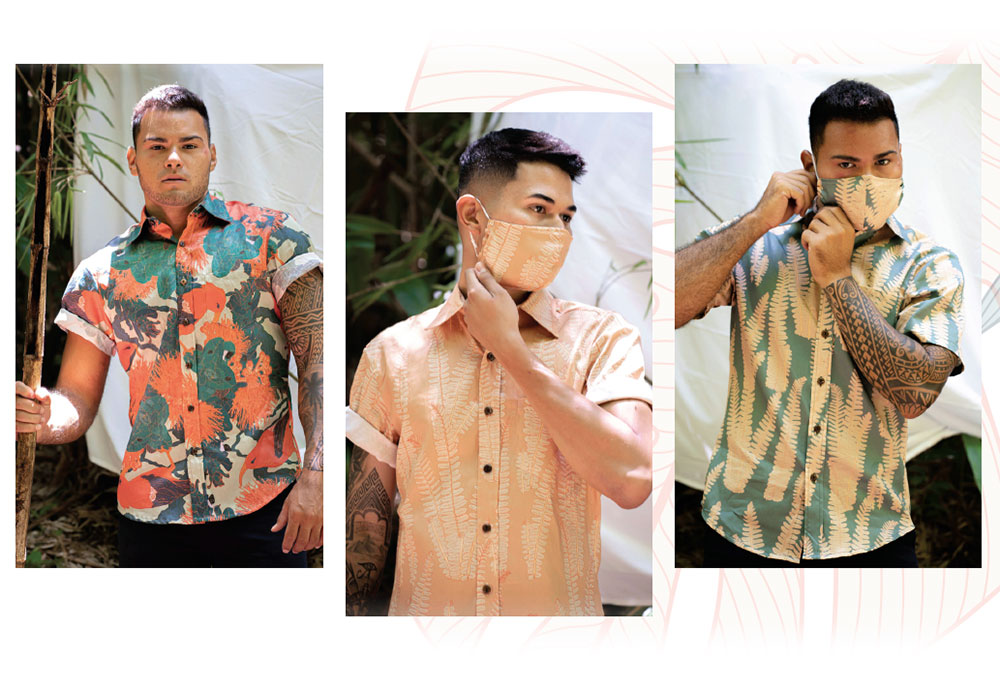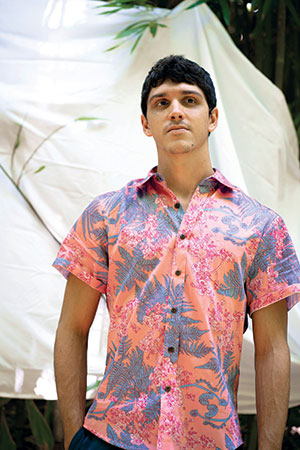DAVID SHEPARD HAS interwoven passions for the natural world, the visual arts and Hawaii into a colorful clothing line featuring self-drawn renderings of the island chain’s native plants.
The Fort Myers native and FGCU grad (’13, Biology) is the creative engine powering Honolulu-based David Shepard Hawaii. (Some may also know him as the son of Joe Shepard, former FGCU vice president for administrative services.) The company sells men’s and women’s, custom-made, aloha shirts and floral-print tote bags, and now, washable cotton COVID-19 protective masks. The masks have been featured in a recent New York Times story on the Smithsonian Institution’s search for pandemic artifacts.
Shepard’s route to becoming a fashion designer and clothier was indeed circuitous.

Honolulu became home after FGCU. He received a master’s degree in horticultural science from the University of Hawaii in 2015. Next came 12 months of horticulture internships split between the National Tropical Botanical Garden on Kauai and on Molokai for the National Park Service, and a summer teaching English at a Buddhist monastery in Myanmar. After returning to Hawaii, Shepard worked as a National Park Service horticultural technician and then as an assistant horticulturist at Lyon Arboretum in Honolulu.

He left that post in June to focus full-time on David Shepard Hawaii, which he’d launched just eight months earlier.
“It was a tough decision, but it was a lot trying to handle both of them,” he said. “I wanted to invest all of myself into this. Right now, I’m focused a lot more on masks. The demand is still growing and it’s helping to broaden my reach so that more people know about my brand. This pandemic won’t last forever and when it’s over I want to be able to continue growing and to have done the legwork of setting up the business’ foundation.”
Making art has been a lifelong interest for Shepard, who minored in drawing at FGCU. After the move to Hawaii, that pursuit initially fell by the wayside, but he resumed drawing while on Molokai, the island’s flora serving as his focal point.
“I was inspired by some of the artists on the island who were also starting to do fabric design and clothing. I started thinking about how I could spread the message of the conservation work we were doing to a broader audience through art and design work.”
Those ruminations continued during Shepard’s time in Myanmar. While there, he decided to dive into shirt making upon returning to Hawaii. So he mastered pattern making using graphic design software and learned how to sew, and when he arrived in Honolulu, Shepard began work on creating his business.

Sales began last October and the first full line of shirts and bags was set to launch this spring. Shepard hoped to make a splash at art fairs and festivals on Hawaii and elsewhere, but those events fell victim to the pandemic.
As he pondered his next move, a seamstress suggested making masks, an idea he resisted until the state’s governor mandated they be worn in public settings.
“That’s when I thought, ‘OK, there’s definitely going to be a demand, it’s probably going to carry on for a while,’” he said. With that, he switched over to mask production and one week after they hit the market, a reporter contacted him about being featured in the May New York Times story. That led to additional press coverage.
“The whole combination of those factors led to masks being my biggest seller,” said Shepard. “All that helped get the word out and launch the masks.”